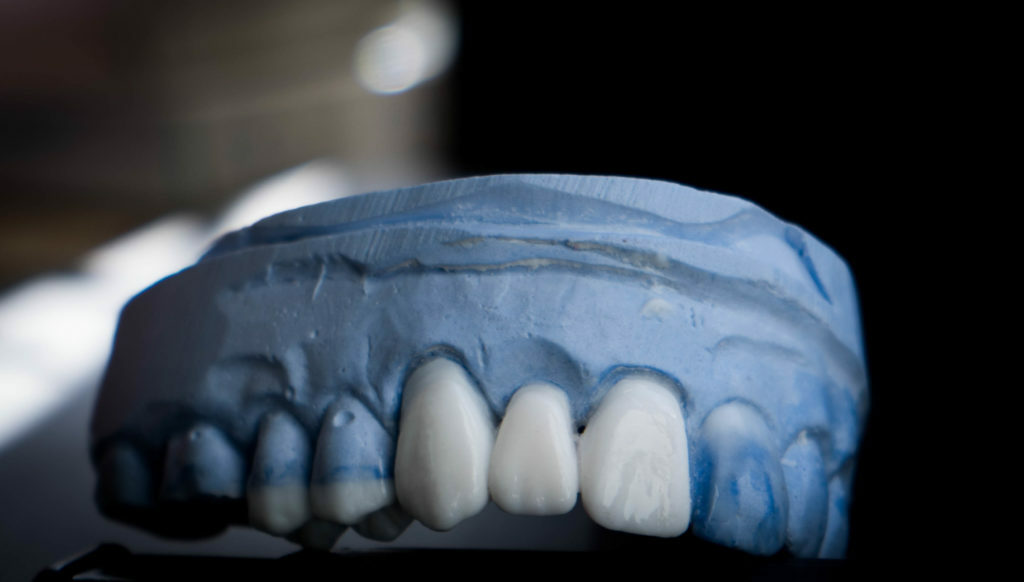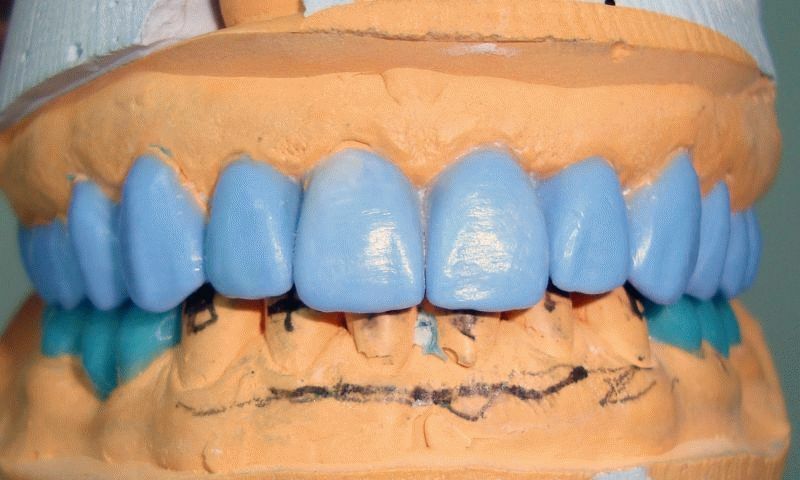 Modeling of teeth is a preparatory stage before the installation of orthopedic products to reproduce the external aesthetic form of the tooth row completely or singly with the help of wax. This moment is necessary for a clear understanding of what the future artificially created smile will look like and make sure of the comfort of such dentures.
Modeling of teeth is a preparatory stage before the installation of orthopedic products to reproduce the external aesthetic form of the tooth row completely or singly with the help of wax. This moment is necessary for a clear understanding of what the future artificially created smile will look like and make sure of the comfort of such dentures.
Wax modeling of teeth is also called Wax-up technique. In translation means material to recreate the model. Otherwise, Wax-up is an integral manipulation when performing dental prosthetics or implantation of an implant system. This procedure is carried out by an individual impression of the oral cavity.
Reproduced wax model of the tooth - this is the basis for creating a permanent orthopedic design. To make an impression was perfectly modeled, all damaged and destroyed teeth should be restored with liquid wax. After hardening, the dental technician can determine the exact contact of the temporal model with the tooth itself and understand how the chewing load is distributed.
When reconstructing the wax model, the patient should not experience any discomfort and inconvenience. Having received all the necessary information on the anatomical features of the oral cavity, the specialist can safely proceed with planning the therapeutic course and the subsequent stage of restoration of the teeth.
Contents of
Contents of
Contents of
Contents of
Modeling of wax
- Indirect method
- Direct method
Features of wax modeling
Dentists-orthopedists use the technique of modeling wax during the restoration of teeth. Wax is a very soft and easily sculptable material that can very accurately recreate the mold replacing the tooth with all its anatomical characteristics. 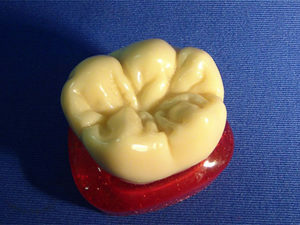
From the accuracy of wax modeling it completely depends on how the patient will feel with the new artificially created prostheses: whether he will be comfortable, painful or not when talking, taking food.
The Wax-up procedure is absolutely safe and without pain, because there is no violation of the integrity of the oral cavity. Modeling is carried out with the use of beeswax, which can lead to cross-reaction in patients suffering from allergies to beekeeping products. In this situation, you will need to change the modeling material.
Why wax modeling
There are three criteria for the need for wax reproduction:
- As already noted, dental modeling from wax is the initial stage in the restoration. It is necessary for planning the subsequent work of specialists( orthopedist and technician).Wax outsole helps doctors to track all the characteristics of the structure of the teeth and not make mistakes in the treatment and implantation.
- As a guide for determining the future cost of services for dental procedures.
- Temporary prosthetics - the dental technician makes waxen outfits to create temporary structures from plastic. This happens in case of the need for a long time for the manufacture of permanent prostheses.
Indications and contraindications
The dentist-orthodontist can prescribe reproduction from wax on the basis of the condition of the oral cavity according to the following indications:
- Dental abrasion by pathological features, which occurs, for example, due to an incorrect bite. Correction of such a defect is assisted by crowns or veneers.
- Increased destruction of the supragingival region, manifested as a consequence of neglected form of caries. In this situation, restoration of the tooth walls is most often required by using a crown or a microstretch.
- Distinctive color. When installing the implant, you can select the desired color, but first you need a simulation procedure.
- There is only a root base from the teeth. Restoration is by means of a pin. If there was a destruction of the entire dentition, the wax modeling is an integral part in the restoration of teeth.
- Adentia - complete absence of teeth. This manipulation is widely applicable in modeling the front row by implanting artificial ones.
- Multiple pathological flaws. If you want to install a bridge structure, several crowns create a wax cast. The prosthetist carries out the procedure Wax-up, which makes it possible to evaluate the cost and comfort of the future product. This manipulation allows you to take into account the individual specifics of the client, his wishes.
Each procedure has its own contraindications, and the Wax-up procedure is not an exception:
- is an acute form of oral pathology;
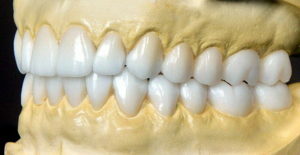
- rehabilitation time after radiotherapy;
- narcotic addiction;
- diseases of the tissues of the bone jaw;
- inflammation processes of a different nature.
Modeling methods
Two methods of Wax-up are used in dentistry.
Indirect method
Creation of an imprint of a future artificial prosthesis based on gypsum. The dentist-technician represents the patient for an acquaintance and receive from him an approving answer to the subsequent manufacture of permanent structures.
This technique is fast enough. Since the patient is not present for a long time at the reception. It is necessary to make molds of the oral cavity qualitatively. The final manufacture of the product takes place in the laboratory, and not in the mouth of the client.
This allows the technician to model the future smile perfectly, having sharpened all edges of the model. An indirect technique is appropriate for teeth that are located in hard-to-reach places.
Direct method
Combination of Wax-up and Mock-up techniques( 3D visualization model) - modeling of a composite impression based on wax in the oral cavity.
To be presented to the patient for examination and installed into the oral cavity with the help of a composite. This method is intended for diagnostic socks for a short time, when understanding the comfort and convenience of the product is required.
Material requirements
In the Wax-up procedure, two types of beeswax are used:
- I type .Actively applied in modeling the direct method directly in the oral cavity of the patient.
- II type .Effective for indirect methods. This version of wax is slightly below the quality, but the final work is not reflected.
When selecting, storing and applying modeling material, it is necessary to draw some rules:
- in order to achieve a more distinct contrast, it is worth using colored waxes, namely red and blue shades are widely used;
- after hardening, the forming material must be rigid and not crumb;
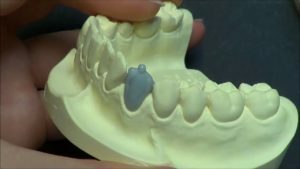
- when heated in mass there can not be any impurities and crumbs, their presence can affect the quality of work, creating a rough surface with reliefs;
- when scraping during shaping the wax should not chipped or fell off pieces;
- should strictly observe the storage time;
- correctly choose the type of material when choosing a technique;
- should be preferred to soft varieties of beeswax or wax.
Preparing for waxing
Before starting the process of modeling a future smile, you need to implement a number of recommendations:
- conduct a diagnosis of the mouth;
- if necessary, computed tomography and x-ray of the jaw;
- for oral diseases to undergo treatment;
- observe the rules of hygiene and conduct sanation of the oral cavity.
Only after a full study and treatment course, an orthodontist and technician can begin to create a Hollywood smile.
Stages of modeling Wax-up
The dental process of Wax-up modeling takes place in several stages:
- takes a plaster or silicone impression of the client's jaw, not only where they will be temporarily placed, but also from the opposite side;
- fixing the jaw from closing by using bite rollers made of silicone;
- creation of jaw specimens by means of a special plate( facial arch) fastened in the ears;
- having received samples, they are transferred directly to the gypsum material;
- fixing the reproduced model on the articulator - a device that simulates the jaw function and allows the technician to adjust the chewing and articulation movements;
- modeling of a cast of wax on plaster models and showing it to the client.
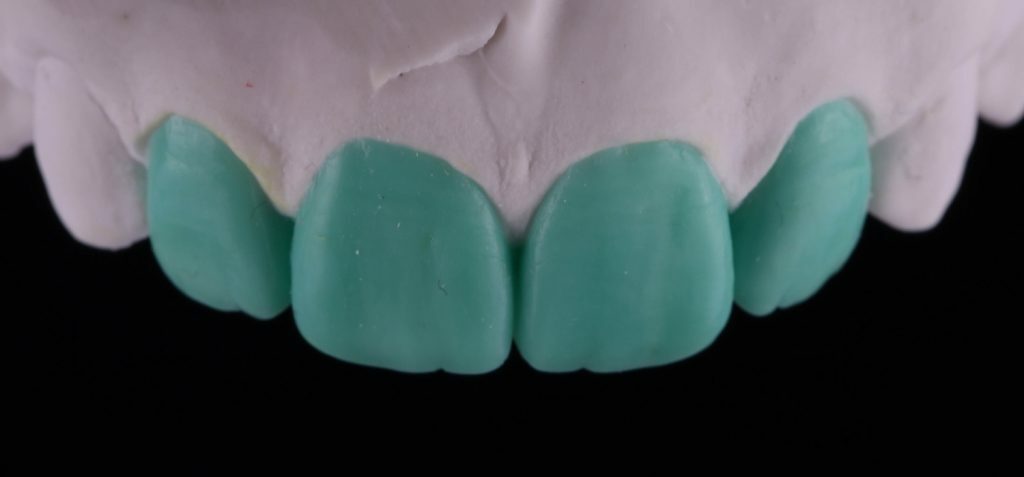
In cases of conversion of the layout into the Mock-up technique, the sample is transferred to the oral cavity and the following manipulations are performed:
- obtains silicone keys, that is, impression from new units;
- deposits( plaque, stone) are eliminated without turning and preparation;
- fix the layout with a special glue;
- laying of plastic or composite material in molds and applying it to teeth;
- removal of silicone keys and their processing by grinding and polishing;
- the final point is the evaluation of the work performed.
The duration of creating a wax model, depending on the specific structure of the jaw and the venue is from 20 to 60 minutes.
Advantages and disadvantages of
Creating wax models is an additional work for dentists-orthodontists, which requires a longer time to get a Hollywood smile and more expenses.
Despite this, experts recommend the procedure, referring to the following criteria:
- during the creation of an artificial smile, even at the modeling stage, you can adjust all the nuances;
- making wax samples allows the client not to spend time getting used to permanent structures;
- elimination of many inconveniences - discomfort, painful sensations, posting, addictive;
- after the stage of wax reproduction the process of preparation is more costly;
- client is fully involved in the process of correcting artificial teeth with a direct method;
- with indirect technique, the client may not have additional time in the dental chair, the manufacture of artificial dentures can be performed without his presence.
The drawbacks of this procedure can be attributed to a small loss of accuracy with an indirect reproduction technique. This is due to the fact that during cooling the wax slightly changes the previous volume.
Price
Installation of an implant system using wax modeling technology
is quite a costly service. It includes not only the cost of materials and special equipment and tools used, but also the professionalism of the specialist.
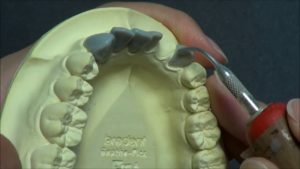 Thus, the cost of services for modeling a single denture is from 1500 rubles in Moscow, and beyond 600 rubles.
Thus, the cost of services for modeling a single denture is from 1500 rubles in Moscow, and beyond 600 rubles.
Price may vary depending on the complexity and the number of modeling units of the dentition. The final cost for wax reproduction is calculated by a specialist after diagnosis.
Having evidence for correcting the teeth, the patient turns to the dentist. When diagnosing and proposing various options to solve the problem, the client begins to doubt the final result. For this, there is a stage of wax modeling.
In the forums, patients share their experience about the cost of services. Many people are worried about the need for such manipulation and are inclined to use it because of the shortening of the time for getting used to the prosthesis and the repeated procedure for revealing the discomfort.
Wax modeling is an additional step in the implantation of teeth and an ideal method for prosthetics using different techniques. This procedure does not do any harm to neighboring teeth, and the material used, the wax - is universal and non-toxic.

